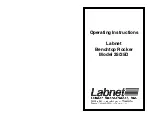
– Evaluate the site conditions of the day to
determine if the slope is safe for machine
operation. Use common sense and good
judgment when performing this evaluation.
Changes in the terrain, such as moisture, can
quickly affect the operation of the machine on
a slope.
•
Operate across slopes, never up and down. Avoid
operation on excessively steep or wet slopes.
Poor footing could cause a slip-and-fall accident.
•
Identify hazards at the base of the slope. Do
not operate the machine near drop-offs, ditches,
embankments, water, or other hazards. The
machine could suddenly roll over if a wheel goes
over the edge or the edge collapses. Keep a safe
distance between the machine and any hazard.
Use a handheld tool to operate in these areas.
•
Avoid starting, stopping, or turning the machine on
slopes. Avoid making sudden changes in speed or
direction; turn slowly and gradually.
•
Do not operate a machine under any conditions
where traction, steering, or stability is in question.
Be aware that operating the machine on wet grass,
across slopes, or downhill may cause the machine
to lose traction. Loss of traction to the drive may
result in sliding and a loss of braking and steering.
The machine can slide even if you stop the drive.
•
Remove or mark obstacles such as ditches, holes,
ruts, bumps, rocks, or other hidden hazards. Tall
grass can hide obstacles. Uneven terrain could
overturn the machine.
•
If you lose control of the machine, step away from
the direction of travel of the machine.
•
Always keep the machine in gear when going
down slopes. Do not coast downhill (applicable
only to gear-drive units).
Starting the Engine
Note:
For illustrations and descriptions of the controls
referenced in this section, refer to
Controls (page 12)
.
Note:
Ensure that the spark-plug wire is installed on
the spark plug.
1.
Ensure that the traction and reel drive levers are
in the D
ISENGAGED
position.
Note:
The engine will not start if the traction
lever is in the E
NGAGED
position.
2.
Ensure that the fuel-shutoff valve is open.
3.
Move the On/Off switch to the O
N
position.
4.
Move the throttle control to the F
AST
position.
5.
Move the choke lever halfway between the
C
HOKE
and R
UN
positions when starting a cold
engine.
Note:
The choke may not be required when
starting a warm engine.
6.
Pull the recoil-start handle out until positive
engagement results, then pull it vigorously to
start the engine.
Important:
Do not pull the recoil rope to its
limit or let go of the starter handle when the
rope is pulled out; the rope may break or the
recoil assembly may be damaged.
7.
Move the choke lever to the R
UN
position as the
engine warms up.
Shutting Off the Engine
1.
Move the traction and reel drive controls to the
D
ISENGAGED
position.
2.
Move the throttle control to the S
LOW
position.
3.
Move the On/Off switch to the O
FF
position.
4.
Close the fuel-shutoff valve before you store or
transport the machine
Releasing the Transmission
If the machine becomes disabled with the motor brake
on, you can disengage the drum from the transmission
to allow the machine to be maneuvered.
1.
On the right rear corner of the machine, locate
the traction engage/disengage lever next to the
drive housing drum (
).
g032413
Figure 30
1.
Traction
engage/disengage
lever-engaged
2.
Traction
engage/disengage
lever-disengaged
2.
Rotate the lever rearward to disengage the
transmission from the drum.
24
















































